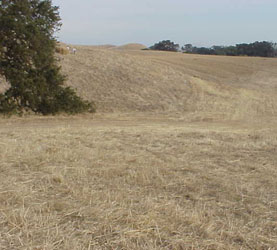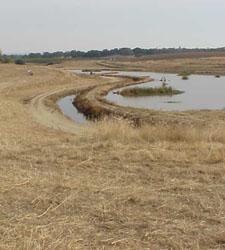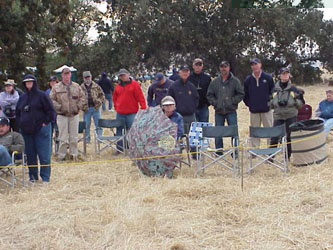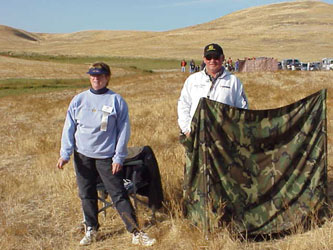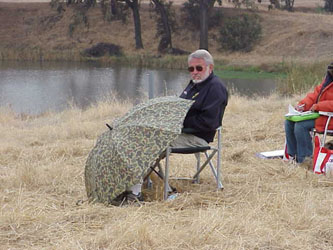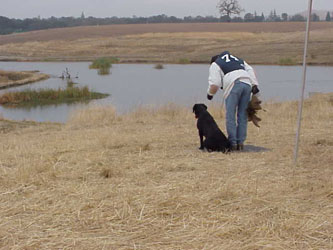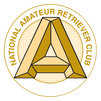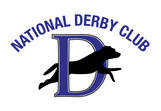Wednesday, November 12, 2003 |
Wednesday arrived clear, cold and with little wind. Temperatures were near freezing; about 33 degrees. A down jacket was a fashion must.
The test had been left standing and was ready to go about 6:15, but there was not enough light. Shortly after 6:30 the single test dogs was called to line. Gary Zellenr and D-Seven, demonstrated that the test carried the same pitfalls as the day before. About 7 a.m., dog 31 was called to line. (He had received a reprieve the evening before as it was too dark to run him)
The work remained about the same with perhaps a few more dogs missing the left blind far water.
There was speculation in the gallery that if the dogs missed the far water, would they have failed the test ?
The series ended about 11 a.m. Callbacks came shortly thereafter and 52 dogs remained. Fifteen had been lost. They were: 15, 18, 19, 32, 35, 38, 50, 57, 66, 67, 70, 72, 73, 87, and 89.
The next series was a short distance down the road and by the time contestants arrived, a test dog was being called to the line.
The test had been left standing and was ready to go about 6:15, but there was not enough light. Shortly after 6:30 the single test dogs was called to line. Gary Zellenr and D-Seven, demonstrated that the test carried the same pitfalls as the day before. About 7 a.m., dog 31 was called to line. (He had received a reprieve the evening before as it was too dark to run him)
The work remained about the same with perhaps a few more dogs missing the left blind far water.
There was speculation in the gallery that if the dogs missed the far water, would they have failed the test ?
The series ended about 11 a.m. Callbacks came shortly thereafter and 52 dogs remained. Fifteen had been lost. They were: 15, 18, 19, 32, 35, 38, 50, 57, 66, 67, 70, 72, 73, 87, and 89.
The next series was a short distance down the road and by the time contestants arrived, a test dog was being called to the line.
Test 6 - Land/Water Triple - 2 Retired Guns
The fifth was a land water triple. The line was set on top of a high point overlooking rolling hayfields on the left (1/3 uncut and 1/3 cut. They sloped down to a pond on the left that had a winding gravel road following the shoreline.. The pond contained small islands, and a peninsula protruding from the far road. The first set was located at the base of the far peninsula. They threw a dead duck flat to the right. It landed in tall grass about half way down the peninsula, 244 yards from line. Next, the gunners in the left, uncut hayfield threw a dead hen pheasant to the right. It fell about 105 yards out. The set was positioned in the cut field to the right, about half way between the other two. They shot a flyer duck back to the left about 163 yards away.. As the dog was sent for it, the other two gun stations retired. The wind angled in and/or across from left to right. As the test progressed the wind rose and it became cloudy.
About 11:20, the test dogs illustrated that the test could be demanding- especially the long peninsula mark- when both handled on it.
The first running dog, #20 arrived at 11:50. The first one or two did quite well, but then the wind switched and turned into the line from right to left. After the wind switch, the long right bird could be winded from a long distance on the left - even on the hill - and a number did so. several dogs missed the opportunity and a few needed to be handled on the far left mark. There were also a number of deep, loose hunts on the left mark. That bird was thrown flat and landed on the side hill. Some dogs drove past it on the upwind side then hunted on top the hill and/or to the deep left of the gunner's blind. Most recovered and did pick up the pheasant after a hunt
The wind remained from the same direction, but varied in intensity throughout the afternoon.
Since the workers party was scheduled for 5 p.m. at a nearby hall, the test was suspended at 4:30 p.m, after #86 had run. There would be no partial callbacks. There would be one test dog at 7 a.m. and dog # 1 will start. There was concern that if the wind shifts overnight, it could be a different test in the morning.
About 11:20, the test dogs illustrated that the test could be demanding- especially the long peninsula mark- when both handled on it.
The first running dog, #20 arrived at 11:50. The first one or two did quite well, but then the wind switched and turned into the line from right to left. After the wind switch, the long right bird could be winded from a long distance on the left - even on the hill - and a number did so. several dogs missed the opportunity and a few needed to be handled on the far left mark. There were also a number of deep, loose hunts on the left mark. That bird was thrown flat and landed on the side hill. Some dogs drove past it on the upwind side then hunted on top the hill and/or to the deep left of the gunner's blind. Most recovered and did pick up the pheasant after a hunt
The wind remained from the same direction, but varied in intensity throughout the afternoon.
Since the workers party was scheduled for 5 p.m. at a nearby hall, the test was suspended at 4:30 p.m, after #86 had run. There would be no partial callbacks. There would be one test dog at 7 a.m. and dog # 1 will start. There was concern that if the wind shifts overnight, it could be a different test in the morning.

